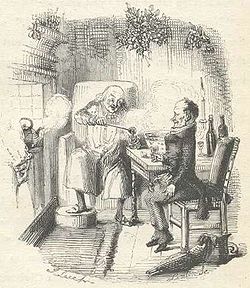
— Ebenezer Scrooge
Smoking bishop is a type of mulled wine, punch, or wassail, especially popular in Victorian England at Christmas time, and it is mentioned in Dickens' 1843 story A Christmas Carol . [1]
Contents
Smoking bishop was made from port, red wine, lemons or Seville oranges, sugar, and spices such as cloves. The citrus fruit was roasted to caramelise it and the ingredients then warmed together. A myth persists[ citation needed ] that the name comes from the shape of the traditional bowl, shaped like a bishop's mitre, and that in this form, it was served in medieval guildhalls and universities.
Other variations of drinks known collectively as "ecclesiastics" [2] included [3] the smoking archbishop (made with claret), the smoking beadle (made with ginger wine and raisins), the smoking cardinal (made with Champagne or Rhine wine) and the smoking pope (made with burgundy).
